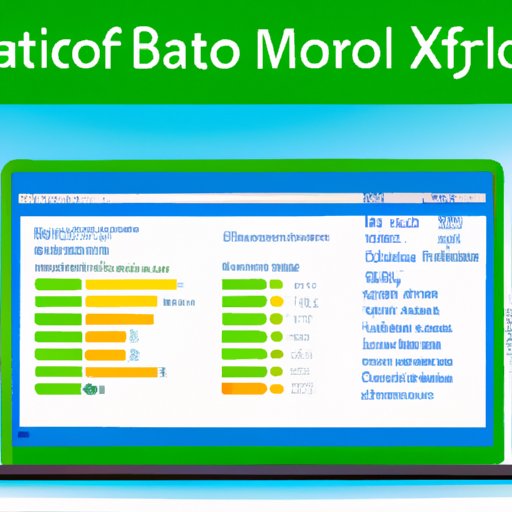Introduction
Excel is a powerful tool for managing data and performing complex calculations. For many users, however, the sheer amount of data and complexity of tasks can be overwhelming. Fortunately, it is possible to automate many of these tasks to make them simpler and more efficient. In this article, we’ll explore the various ways in which you can automate Excel and make your life easier.
What is Excel Automation?
Excel automation is the use of tools and techniques to streamline repetitive or tedious tasks. It involves automating processes such as data entry, sorting, filtering, and analysis. By automating these processes, you can save time, reduce errors, and gain insights into your data more quickly. Excel automation can also be used to create custom reports, dashboards, and other documents that are tailored to your specific needs.
Benefits of Automating Excel
The benefits of automating Excel are numerous. For starters, it can help you save time by eliminating the need to manually perform tedious tasks. Additionally, automation can help reduce errors, since manual data entry is prone to mistakes. Automation can also help you gain insights into your data faster, since it eliminates the need to manually search through large datasets. Finally, automation can help you create custom reports, dashboards, and other documents that are tailored to your specific needs.
Utilizing Macros and VBA
One of the most popular methods for automating Excel is the use of macros and Visual Basic for Applications (VBA). Macros are small programs that can be written to automate tasks in Excel. VBA is a programming language that is used to write macros. It allows users to create custom scripts that can be used to automate certain tasks.
Understanding VBA
Before writing macros, it is important to have a basic understanding of VBA. VBA is a scripting language that is used to write macros. It is based on the Visual Basic programming language, and has its own syntax and commands. To get started with VBA, it is recommended that you familiarize yourself with the basics of the language, including variables, functions, and logic statements.
Writing Macros
Once you have a basic understanding of VBA, you can start writing macros. Macros are small programs that can be used to automate tasks in Excel. To write a macro, you will need to open the Visual Basic Editor (VBE) and start writing code. The code should be written using VBA syntax, and should include commands that tell Excel what to do. Once you have written the code, you can save it as a macro and run it whenever you need to.
Implementing Macros
Once you have written a macro, you can implement it in Excel. To do this, you will need to open the macro in the VBE and then click the “Run” button. This will execute the macro and perform the tasks specified in the code. You can also assign a shortcut key to the macro so that it can be executed with a single keystroke.
Using Excel Functions to Automate Tasks
In addition to macros, Excel also has a variety of built-in functions that can be used to automate tasks. These functions allow you to quickly perform calculations, look up data, and manipulate text. Excel also has a variety of statistical functions that can be used to analyze data. By utilizing these functions, you can automate many of the tasks that would otherwise require manual effort.
Exploring Built-in Functions
Excel has a variety of built-in functions that can be used to automate tasks. These functions can be found in the “Formulas” tab of the ribbon. Here, you can find a wide range of functions, from basic math and text manipulation functions to more advanced statistical functions. By exploring the available functions, you can find ones that can help you automate your tasks.
Creating Custom Formulas
In addition to the built-in functions, you can also create custom formulas to automate tasks. This can be done by entering the formula directly into a cell or by creating a named range. Named ranges allow you to assign a name to a range of cells, which can then be used in formulas. This can help simplify formulas and make them easier to understand and use.

Exploring the Power of Pivot Tables
Pivot tables are one of the most powerful features in Excel. They allow you to quickly summarize and analyze large amounts of data. By leveraging pivot tables, you can automate many of the tasks that would otherwise require manual effort. In this section, we’ll explore how to set up and use pivot tables to automate tasks.
Setting Up a Pivot Table
To set up a pivot table, you will first need to select the range of cells that you want to use. This range should contain all of the data that you want to analyze. Next, you will need to select the fields that you want to include in the pivot table. This can be done by clicking the “Fields” tab in the ribbon. Finally, you can customize the pivot table by adding filters, sorting, and formatting.
Working with Data Fields
Once you have set up the pivot table, you can begin working with the data fields. This can be done by selecting the “Data” tab in the ribbon. Here, you can select the fields that you want to include in the pivot table and specify how they should be displayed. You can also add additional fields to the pivot table if needed.
Analyzing Data with Slicers
Slicers are a useful tool for analyzing data in pivot tables. They allow you to quickly filter and sort data by selecting specific criteria. To use a slicer, you will first need to select the field that you want to filter by. Then, you can select the criteria that you want to filter by. This will update the pivot table to show only the data that matches the criteria.
Creating Custom Excel Workbooks
Excel workbooks can be customized to meet your specific needs. This can include creating custom templates, adding visual elements, and developing dashboards. By creating custom workbooks, you can automate many of the tasks that would otherwise require manual effort.
Working with Templates
Excel comes with a variety of built-in templates that can be used to quickly create custom workbooks. These templates can be accessed by clicking the “New” button in the ribbon. Here, you can select from a variety of templates, including budget templates, calendar templates, and project management templates. By using these templates, you can quickly create workbooks that are tailored to your specific needs.
Adding Visual Elements
In addition to templates, you can also add visual elements to your workbooks. This can include charts, graphs, and images. These elements can help make your workbook more engaging and easier to understand. Additionally, they can help you quickly identify trends and patterns in your data.
Developing Dashboards
Dashboards are a great way to quickly view and analyze data. They provide an overview of key metrics and performance indicators. By creating custom dashboards, you can easily monitor your data and identify areas for improvement. Additionally, dashboards can be automated to update their data in real time.

Taking Advantage of Microsoft Flow
Microsoft Flow is a cloud-based workflow automation service. It allows you to connect apps and services together to automate workflows. For example, you can use Flow to automatically send emails when a new item is added to an Excel spreadsheet. Flow can be used to automate many of the tasks that would otherwise require manual effort.
Connecting Apps & Services
The first step in using Flow is to connect apps and services. This can be done by clicking the “Connections” tab in the ribbon. Here, you can select the apps and services that you want to connect. Once connected, you can start creating workflows to automate tasks.
Automating Workflows
Once you have connected the apps and services, you can begin automating workflows. This can be done by selecting the “Workflows” tab in the ribbon. Here, you can create workflows by specifying triggers, conditions, and actions. Triggers determine when the workflow should be executed, conditions determine what should happen, and actions determine the actions that should be taken. By combining these elements, you can create workflows that automate tasks.
Utilizing Conditional Formatting
Conditional formatting is a powerful feature in Excel that allows you to quickly highlight data points. This can be done by applying rules that determine when data points should be highlighted. For example, you can apply a rule that highlights cells containing numbers greater than a certain value. By utilizing conditional formatting, you can quickly spot trends and anomalies in your data.
Applying Rules
To use conditional formatting, you will first need to apply a rule. This can be done by selecting the “Conditional Formatting” tab in the ribbon. Here, you can select a rule type, specify the criteria for the rule, and choose a format for the cells that match the criteria. Once the rule is applied, the cells that match the criteria will be highlighted.
Highlighting Data Points
Once you have applied the rule, you can use it to quickly highlight data points. This can be done by selecting the cells that you want to highlight and then clicking the “Highlight Cells” button. This will apply the conditional formatting rule to the selected cells and highlight any cells that match the criteria.
Leveraging External Data Sources
Excel can also be used to access and analyze data from external sources. This can include databases, websites, and online services. By leveraging external data sources, you can quickly gather data and automate tasks. Additionally, you can use the data to create custom reports and dashboards.
Importing Data from Other Sources
To access data from external sources, you will first need to import it into Excel. This can be done by clicking the “Data” tab in the ribbon. Here, you can select the source of the data and specify how it should be imported. Once the data is imported, you can use it to automate tasks.
Connecting to Online Services
In addition to importing data, you can also connect to online services. This can be done by clicking the “Connections” tab in the ribbon. Here, you can select the online services that you want to connect to. Once connected, you can use the data from the services to automate tasks.
Conclusion
Excel automation can help you save time, reduce errors, and gain insights into your data more quickly. There are a variety of tools and techniques that can be used to automate tasks in Excel, including macros and VBA, functions, pivot tables, custom workbooks, Microsoft Flow, conditional formatting, and external data sources. By leveraging these tools and techniques, you can make your life easier and get the most out of Excel.
(Note: Is this article not meeting your expectations? Do you have knowledge or insights to share? Unlock new opportunities and expand your reach by joining our authors team. Click Registration to join us and share your expertise with our readers.)
